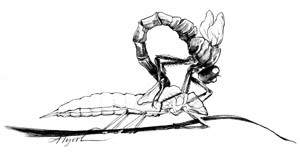
Dragonflies are nature’s aeronautical marvels. Whether darting over water at 35 miles per hour or hovering in midair, they are a spectacle of colors in motion—from a delicate blue-green translucency to a jack-o’-lantern black and orange.
It’s no surprise that dragonflies have entered the lore of writers and cultures over the ages. Henry David Thoreau once called them “devil’s needles,” though he certainly knew they were harmless. Centuries ago, Samurai warriors of Japan incorporated them into family crests that signified victory over enemies. Navajos of the American Southwest offer a more positive spin – they believe dragonflies to be a symbol of water purity.
About 450 species of dragonflies and their close relatives, damselflies, live in North America, with about 150 of those species living in New Hampshire and Vermont. Dragonflies and damselflies belong to the same order of insects, odonates, and look similar in many ways, but dragonflies have thicker bodies, their wings beat twice as fast and at rest their wings remain spread. Delicate damselflies rest with wings folded together over their back.
Dragonflies can hover, fly sideways and backwards, mate on the wing and turn 90-degrees on an aerial dime. Sighting their prey, they calculate a trajectory and fly directly to that point of interception. They prey upon other insects, among them mosquitoes, so humans should bear them no malice.
They maneuver well in air, but also in water – during their nymph stage. Dragonfly eggs hatch into voracious aquatic nymphs that feed on other insects and virtually anything small enough to swallow. One characteristic of dragonfly nymphs that helps them catch prey: Their gills line a rectal chamber from which they shoot water for a kind of jet propulsion.
After living two to four years underwater, and molting roughly a dozen times, they crawl up onto stems, rocks or leaves at night or in the early morning during the warm season and squeeze out of a split in the skin on their backs. They inflate their adult bodies with air and pump up the wings hydraulically with blood. The wings are then spread out to dry in the sun, and soon the dragonfly is free to take off.
Dragonfly nymphs, it turns out, are barometers of water quality, says
Steve Fiske, aquatic biologist/benthologist for the Vermont Department of Environmental Conservation. Because they live in the same habitat for two-to-three years, monitoring nymph populations over time gives a good indication of whether a habitat has been “disturbed or polluted,” he says.
Dragonflies are especially vulnerable to habitat disturbance, since it takes 30 minutes or more for their adult wings and bodies to form and harden. During this critical time they need something to crawl up onto in order to get away from the water and remain undisturbed. A natural shoreline strewn with logs, rocks or plants is needed, or the vulnerable young adults may emerge too close to the water line and be damaged by the smallest waves and wakes.
Biologists rate aquatic insects on a scale of zero to 10, based on the water quality they require. Those associated with low numbers require clean water, and those higher on the scale can survive in water with less oxygen and moderate-to-high organic pollution.
Different types of dragonflies and damselflies have different rankings on the 10-point scale, which helps researchers determine water quality in a given area.
Nymphs of the blackwinged damselfly, for example, are found in cool, flowing streams that readily hold oxygen.
But many nymphs, such as those of the dragonhunter, are to be found in ponds, marshes and lakeshores with medium levels of dissolved oxygen and moderate amounts of organic pollution.
Pollution-tolerant nymphs include those of the familiar bluet damselfly and those of various dragonflies, such as the common green darner, the twelve-spotted skimmer and the common whitetail.
Dragonfly and damselfly nymphs are used by biologists with the Connecticut River Watershed Council to gauge water quality. The New Hampshire Dragonfly Survey—a project of the New Hampshire Audubon Society, New Hampshire Fish and Game and UNH Cooperative Extension Service—also uses them as indicators of water quality.
Dragonfly researchers and aficionados are protective and passionate about dragonflies and damselflies—these aerial acrobats and their nymphs. In Vermont, in fact, a group of volunteers conducts research on dragonflies and damselflies and publishes the results in an on-line newsletter, The Boghaunter.

